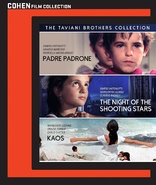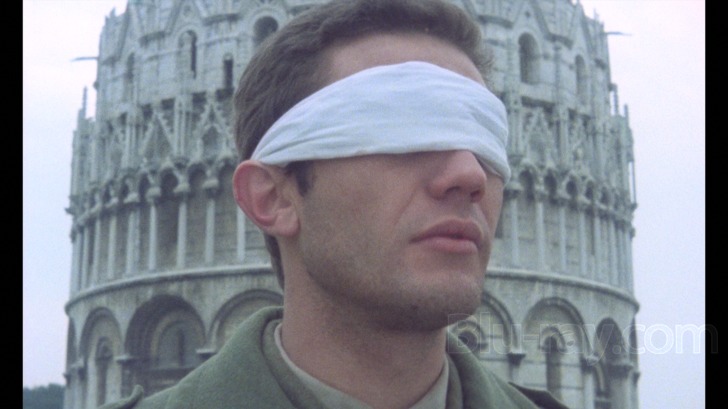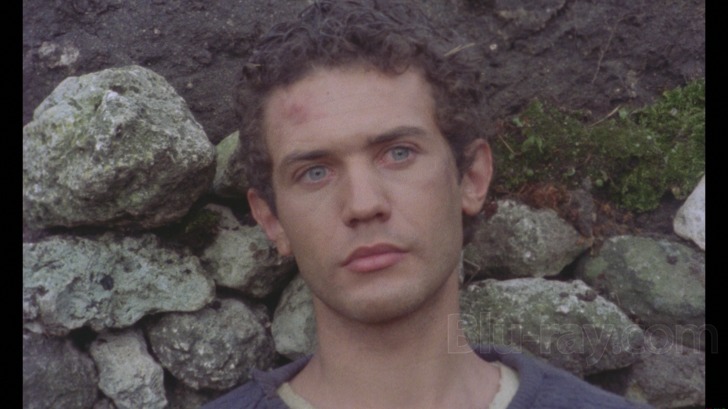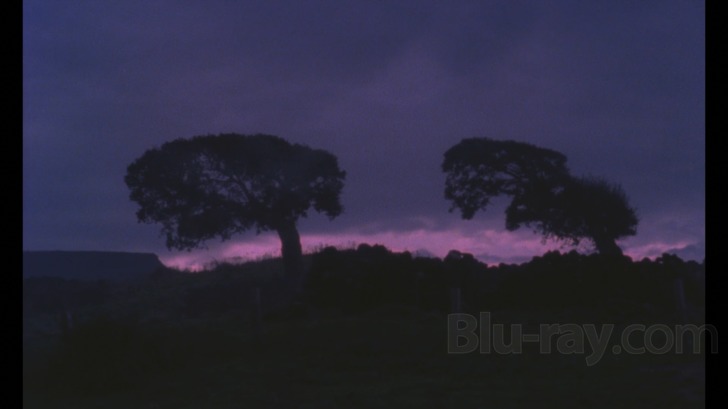Padre Padrone Blu-ray Movie
HomePadre Padrone Blu-ray Movie 
Father and MasterCohen Media Group | 1977 | 114 min | Not rated | No Release Date

Price
Movie rating
7.1 | / 10 |
Blu-ray rating
| Users | 0.0 | |
| Reviewer | 4.0 | |
| Overall | 4.0 |
Overview
Padre Padrone (1977)
The story of young, barely literate shepherd boy Gavino who lives under the thumb of his tyrannical peasant father. He is ultimately rescued from his family and his isolated lifestyle by a call to military service, eventually emerging as a brilliant linguist and scholar.
Starring: Omero Antonutti, Marcella Michelangeli, Saverio Marconi, Stanko Molnar, Nanni MorettiDirector: Paolo Taviani, Vittorio Taviani
| Foreign | Uncertain |
| Drama | Uncertain |
| Biography | Uncertain |
Specifications
Video
Video codec: MPEG-4 AVC
Video resolution: 1080p
Aspect ratio: 1.67:1
Original aspect ratio: 1.66:1
Audio
Italian: LPCM Mono (48kHz, 24-bit)
Subtitles
English
Discs
50GB Blu-ray Disc
Single disc (1 BD)
Playback
Region A (B, C untested)
Review
Rating summary
| Movie | 4.0 | |
| Video | 3.5 | |
| Audio | 3.5 | |
| Extras | 2.0 | |
| Overall | 4.0 |
Padre Padrone Blu-ray Movie Review
Reviewed by Jeffrey Kauffman February 16, 2016Note: This film is available as part of
The Taviani Brothers Collection.
The history of Italian cinema in the post World War II era is a really fascinating subject, though one that often is traditionally shorthanded to
concentrate largely if not solely on neorealism. That now iconic genre, as evidenced by such legendary films as Rome, Open City, The
Earth Trembles, Bicycle Thieves and Umberto D. introduced (or at least reintroduced) global
audiences to such incredible filmmakers as Roberto Rossellini and Vittorio de Sica while also offering (especially American) audiences movies
that were in some ways diametrically opposite to the glossy, staged and often predictably formulaic entries that had tended to be part of
Hollywood’s studio system. (It’s interesting to note that the typically grittier film noir popped up in Hollywood at around the same
time as neorealism, something that might indicate a more universal attempt to bash through norms of presentation.) But while neorealism is
often used as a catch all into which some unlikely suspects are stuffed (like Federico Fellini, albeit for his less whimsical fifties work like La Strada), anyone who takes the time to pore over the huge gamut of films
which were produced and released in Italy even in the few years directly after World War II would have to admit that there was a lot more
going on than “just” neorealism. The sixties saw the rise of filmmakers (like Fellini, in fact) who pushed the stylistic envelope in ways that
the neorealists never would have, and as time and society moved on past the hardscrabble days of the late forties and early fifties, it’s at
least arguable that some elements of Italian cinema actually started to ply territory that was in fact closer to the glossy, staged and
predictably formulaic efforts that (at least once, and maybe continually) typified Hollywood. While a number of different genres or at least
cinematic niches popped up in Italy in the ensuing years, including giallo (Castle of Blood, included as an extra on Nightmare Castle, The Bird With the Crystal Plumage), perhaps
understandably Italian cinema became even more fragmented and varietal as the seventies gave way to the eighties. That may be one
reason
why the films of brothers Paolo and Vittorio Taviani can sometimes be hard to peg, at least accurately. The two are on record (including in
some lengthy interviews included as supplements on this new Blu-ray set) as stating that neorealism unavoidably played a part in their
cinematic upbringings, and therefore became a perhaps subliminal influence on their work, but there are other elements of the Tavianis’
oeuvre which don’t fit quite so neatly in that (or in fact any) preconceived category.

If it’s perhaps at least arguable that filmmakers like Fellini countered neorealism with a hallucinatory, near surreal at times take on things that might be termed an almost theatrical “heightened realism”, the Tavianis’ oeuvre might be understood in part as combining these two elements. There’s quite a bit of Padre Padrone that would fall pretty squarely in a typical neorealistic mode, including an emphasis on the underprivileged and a ubiquitous utilization of real locations (in this case, Sardinia). But in other ways, notably some presentational aspects, the film is deliberately unrealistic (neo or otherwise), with (to cite just one example) bookending segments that cast a deliberately “meta” theatrical light on events which may remind some lovers of Italian literature and drama of Luigi Pirandello (Pirandello’s work provides the source material for the Tavianis’ Kaos, included in the same set as this film). (This film is based on a real life memoir by Gavino Ledda, who is seen in the "meta" bookends alluded to above.)
In other ways, though, there’s no denying that Padre Padrone traffics in a neorealistic ambience that may remind cineastes of some of the most iconic films in this genre from the 1940s. The film’s first sequence details the almost horrifying realization on the part of little schoolboy Gavino (Fabrizio Forte) that his martinet father (Omero Antonutti) has shown up at school in order to drag the hapless boy out of classes in order to (probably) spend the rest of his life as a sheep herder. There’s a visceral intensity to the scene despite its inherent theatricality, with little Gavino losing control of his bladder and several other little boys in the class crying either due to the father’s outburst or (just as likely) due to the realization that their day is coming soon enough.
Little Gavino is forced to endure a number of humiliations, both physical and psychological, at the hands of his seemingly deranged father, but surprisingly as discomfiting as many of these scenes are, there’s still an unlikely gentleness to much of what is being portrayed, including a sweet moment when Gavino finds an unexpected friend in the fields. The film ultimately segues to several years later when a young adult Gavino (Saverio Marconi) starts to explore aspects of both culture and the greater world beyond the Sardinian countryside, pushing the film into a somewhat broader scoped examination of a young man finding his “true self”.
Despite an “arc” for Gavino that might be described as at least relatively heroic, there’s still a rather melancholic air to much of Padre Padrone. Somewhat interestingly, considering some of the more disturbing elements of the character, the father doesn’t come off as a complete villain, and in fact is revealed to be as much a “victim” of circumstance as Gavino (initially) is. Padre Padrone is notable for its elegiac qualities, which often spill out in some disarmingly beautiful shots of the countryside, a region that is undeniably gorgeous but which seems to exist as an almost inescapable prison for some of its inhabitants.
Padre Padrone Blu-ray Movie, Video Quality 

Padre Padrone is presented on Blu-ray courtesy of Cohen Film Collection with an AVC encoded 1080p transfer in 1.67:1. Filmed in 16mm (and originally broadcast on Italian television), Padre Padrone has a rather gritty, unvarnished appearance that some may feel is somehow "lacking" in this high definition presentation, though this transfer certainly accurately recreates the theatrical exhibition I experienced when I first saw this film in the 1970s. (A brief text card at the outset of the film indicates this was sourced off the original 16mm negative.) The smaller format means that detail is never at contemporary levels of sharpness and nuance, and there are perhaps arguable minor deficits in the palette that keep things from ever popping very dramatically, something that tends to only add to the emotional tenor of Gavino's journey. With an understanding of the source format and its inherent limitations, along with a further understanding of the context of the Tavianis' filming style (one which often utilizes natural lighting conditions), this is a solid looking transfer that preserves the admittedly lo-fi ambience of the film in an organic and pleasing manner. I'm giving this a 3.5 to differentiate it from the two other films in the Taviani Brothers set (both of which were filmed in 35mm and have better detail as a result), but if I were able to, I'd at least incrementally up the score by a few degrees.
Padre Padrone Blu-ray Movie, Audio Quality 

Padre Padrone's somewhat limited sonic ambitions are presented via an LPCM mono track in the original Italian (with optional English subtitles). The film's dialogue and ambient environmental effects are presented with decent if perhaps slightly underwhelming fidelity, at times assuming a slightly boxy sound (especially with regard to some effects like wind). While not overly impressive, the soundtrack has no problems with regard to damage or distortion.
Padre Padrone Blu-ray Movie, Special Features and Extras 

- Taviani Brothers Interview - Part 1 (1080p; 48:31) presents the siblings with Richard Pena and Alessia Pallanti which covers a rather wide swath of material, including the early influence of neorealism and their approach toward making their films. This first part covers their early lives and careers through Padre Padrone. In Italian with English subtitles.
- Re-release Trailer (1080p; 1:25)
Padre Padrone Blu-ray Movie, Overall Score and Recommendation 

Padre Padrone was a fairly controversial Palme d'Or winner in its day, but it still offers an unforgettable and frequently quite emotional experience. Performances are often quite viscerally compelling, and the film manages to be surprisingly hopeful in what often seem to be hopeless circumstances. Video quality can only do so much with the limitations of the source format, and audio is similarly circumscribed, but both elements are absolutely fine when understood contextually. Highly recommended.
Similar titles
Similar titles you might also like
(Still not reliable for this title)

The Night of the Shooting Stars
La notte di San Lorenzo
1982

Kaos
1984

Il Posto
1961

A Story of Floating Weeds
浮草物語
1934

Misunderstood
Incompreso
1966

The Wild Pear Tree
Ahlat Ağacı
2018

La Dolce Vita
1960

The Banishment
Izgnanie
2007

The Tree of Wooden Clogs
L'albero degli zoccoli
1978

The Rocket
2013

The Conformist
Il Conformista | 4K Restoration
1970

The Dance of Reality
La danza de la realidad
2013

Amarcord
1973

The Gospel According to St. Matthew
Il vangelo secondo Matteo
1964

The Diving Bell and the Butterfly
Le scaphandre et le papillon
2007

Through a Glass Darkly
Såsom i en spegel
1961

Winter Light
Nattvardsgästerna
1963

After the Storm
海よりもまだ深く / Umi yori mo mada fukaku
2016

Il Divo
2008

Christ Stopped at Eboli
Cristo si è fermato a Eboli / Full-Length Version
1979